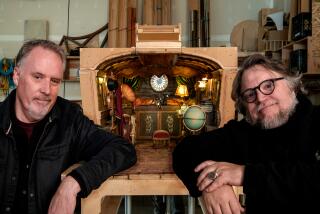Oneida tribal tales emerge transformed
THE TOUCHY part of the Oneidas’ animated short was depicting how the raccoon, after playing dead, gobbles up all the cute dancing crawfish celebrating his demise.
The filmmakers showed the raccoon’s feast as a cloud of mayhem. But there were arms flying out, tiny arms from those adorable crawfish, a detail that risked being far too graphic for kids. And captivating them was the idea of telling an old tribal tale in a way that would teach new generations its message: that even if you’re a cute little crawfish, you’ll pay a dear price if you boast, and lie . . . as one crawfish did by claiming to have slain their predator.
But the flying arms were edgy, and fun, in a 21st century way. So Dale Rood and his crew left ‘em in and began submitting the eight-minute “Raccoon & Crawfish” to festivals such as Moondance. “Oh, yeah, wow, that was a strange animation,” recalled Moondance’s executive director, Elizabeth English, who hesitated to take the short because one of her goals is promoting nonviolent conflict resolution.
You don’t get many tribes submitting films, however, so she waited to see how an audience and jury reacted to the end, in which the raccoon sits satiated, while inside his swollen belly one crawfish lectures the boaster, “You are a liar!”
That’s how “Raccoon & Crawfish” won Moondance’s Sandcastle Award for best animation a year ago, and by now it’s been screened at 64 festivalsaround the world and won 13 awards, and there soon will be more animated shorts telling legends of the Oneida.
Uses for casino profits
WHEN gambling began transforming Indian communities, there was opposition within many tribes from elders and others who said casinos would desecrate traditions. Gambling proponents would argue that there did not have to be a conflict -- that casino profits might help carry on traditions.
Two decades later, it’s happening -- the slot machines indeed are funding efforts to preserve tribal history and culture, often through film.
UCLA-trained Sandra Johnson Osawa, a member of Washington’s Makah tribe, has produced a documentary on Native American prima ballerina Maria Tallchief, funded by the area’s Muckleshoot Indians, and is helping Oklahoma’s Miami tribe use gambling income to document its tribal language, whose last speaker died in the 1960s.
Michael Smith, who stages an annual American Indian Film Festival in San Francisco, regularly brings a touring program to California’s small rancherias -- paid for by their casinos -- to teach Native American youngsters filmmaking “as a tool for personal and community storytelling.” One of Smith’s instructors, Jack Kohler, has helped the Rumsey Band of Wintun Indians make a film in the tribal language and worked with the Auburn Rancheria north of Sacramento to build movie-making facilities with proceeds from its casino. Among its projects is “Red Road to Nirvana,” about “an urban Indian who needs to go back and preserve his roots and along the way becomes a stand-up comedian.”
Of course, not everyone gets a “yes” from such tribes. “It’s been a tough nut for us to crack,” said Shirley K. Sneve, executive director of Native American Public Telecommunications, which provides programming to public TV and radio. “Casinos don’t see us as an investment that will put more quarters in the slot machines.”
But several tribes backed actor Rick Schroder’s 2004 “Black Cloud,” a full feature about a Navajo boxer. And Connecticut’s Mashantucket Pequots, with the vast Foxwoods casino, earlier financed “Naturally Native,” the debut film of Valerie Red-Horse, a Cherokee who, like Osawa, got her training at UCLA. Los Angeles-based Red-Horse has a “day job” as an investment banker but is getting funding from various tribes for a new feature on Ponca Indian Chief Standing Bear, who was arrested in 1879 after attempting to return to his homeland to bury his murdered child. She also is following up her PBS documentary on WWII’s Navajo “code talkers” with one on Choctaws who played the same role in WWI. The doc’s backer? “The Choctaw Nation of Oklahoma.”
‘Why don’t I . . . ?’
AS A kid, Dale Rood would get up early to help his dad salvage parts from junked cars. But after school, he’d catch the TV cartoons, like “Rocky & Bullwinkle” or “The Flintstones.” “I’d watch religiously,” he said.
Rood, part of the Oneida Indian Nation’s Turtle Clan, was a computer technician when the tribe opened Turning Stone casino in 1993, then two years later got video equipment. “The equipment sat for a number of months and so I asked my boss, ‘Why don’t I at least get it working?’ ” Rood recalled. “Well, I did that and, being one of the leaders of the nation, I said, ‘Man, we can do a whole lot more with this technology than just creating commercials.’ ”
The tribe did form Four Directions Media, billing it as “the first film and television production company, 100% American Indian-owned and operated,” and produced a one-hour network show on Indian Dance, which ran in 2003. By then, the equipment Rood wanted was less expensive and they decided to do more animation.
As director of studio operations he hired several young animators trained at Rochester Institute of Technology and between income-generating jobs had them develop characters to tell one of the fables his grandmother used to recite, about a hungry raccoon and the crawfish who tried to outsmart him. It took them more than a year to complete the eight minutes, with music by Brent Michael Davids, a Mohican, using rattles and water drums.
On a recent afternoon, studio manager Tracy Morris screened footage for a documentary on the sacred Sun Dances on South Dakota’s Pine Ridge reservation, a collaboration with the Oglala Lakota Sioux he called “very slow, methodical, ‘let’s make sure we don’t do this wrong.’ ” Then Morris headed out to film an Oneida who still makes lacrosse sticks out of wood.
The animators’ offices were decorated with posters from groundbreaking Disney and Pixar features. On the screen of graphic artist Peter Hale were two new characters, a tribal elder and little boy, seated around a fire, part of the plan to carry the tribe’s animation to a new level.
For all they knew, “Raccoon & Crawfish” could have been a one-and-out effort. Then came the festival showings that evoked the Hank Snow hit “I’ve Been Everywhere,” as the Oneidas and their short made the scene from Cannes to London as well as Big Bear, screening there as wildfires approached. The flip side? A screening in an Iceland “ice theater.”
“It’s daunting, but what’s neat about running the circuit is you get a pretty good feel for what people think of your film,” Rood said. “We’re finding people want to see stuff like this.”
Thus the new characters, designed to introduce “Raccoon & Crawfish” and other animated tribal tales. It’s all on a “Legends From the Oneida” poster, a series of five, including “The No-Face Doll,” the story of how the creator transformed a corn husk into a beautiful doll who becomes vain and, like the crawfish, pays for her failing.
Rood credits Ray Halbritter, the Oneidas’ leader, with defining the mission during a trip to South Dakota, where they saw ancient Lakota rock drawings of the Sun Dance. “They had petroglyphs all over. And Ray said, ‘Well, these videos we’re doing, preserving what we have today, these are our petroglyphs.’ ”
More to Read
The biggest entertainment stories
Get our big stories about Hollywood, film, television, music, arts, culture and more right in your inbox as soon as they publish.
You may occasionally receive promotional content from the Los Angeles Times.






